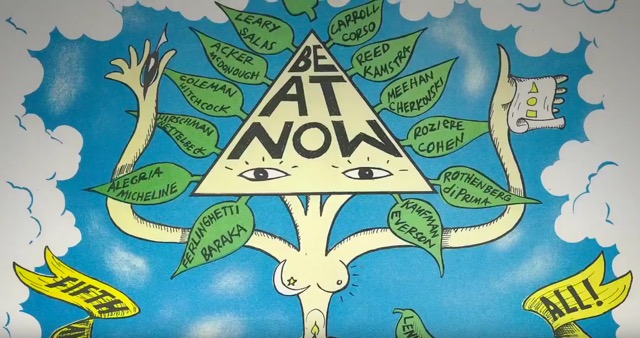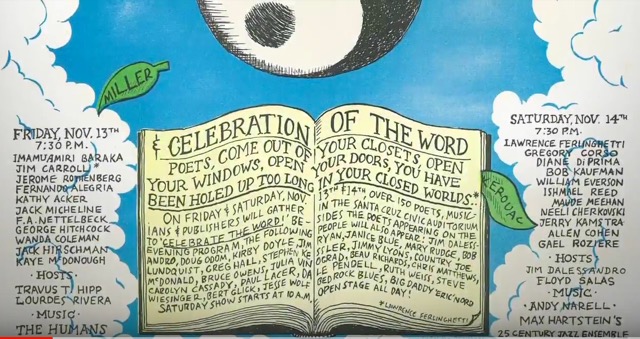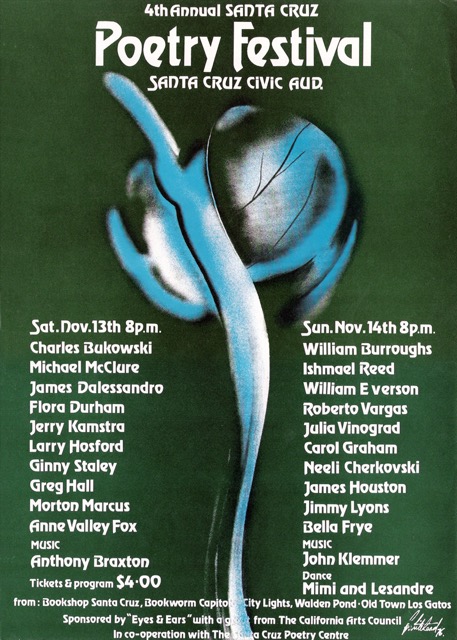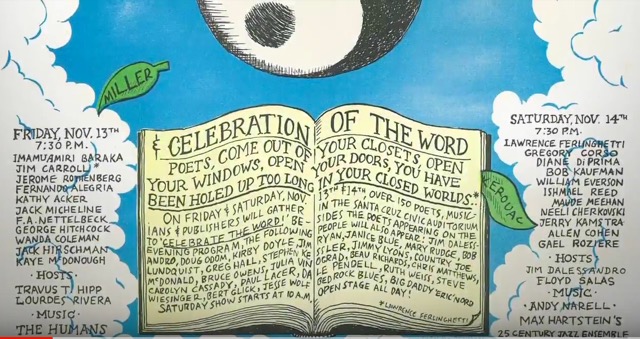
Interview with writer James Dalessandro by J. Macon King
This interview was originally done and published for our Fall 2018 edition.
James Dalessandro seems to have mastered diversification of the literary life. The San Rafael, CA Dalessandro has published four books, including his historical fiction masterwork, 1906, is the award-winning writer, director and producer of a documentary film, and turned his true-crime book into a TV movie. He wrote over seventy-five trailer campaigns, mostly for Columbia Pictures.
After selling more than a dozen screenplays, Dalessandro taught screenwriting at two schools and is a regular speaker at writer conferences. Dalessandro has written for Dan Aykroyd, and Ray Manzarek of The Doors for radio programs.
As a young poet he co-founded The Santa Cruz Poetry Festival, which set attendance records of over 2,000 people per night. He hung out with the counterculture’s literary outlaws — Bukowski, Ginsberg, Snyder, McClure, Jerry Kamstra, Ferlinghetti. And, oh yes, he literally wrestled the heavyweight Merry Prankster himself, Ken Kesey.
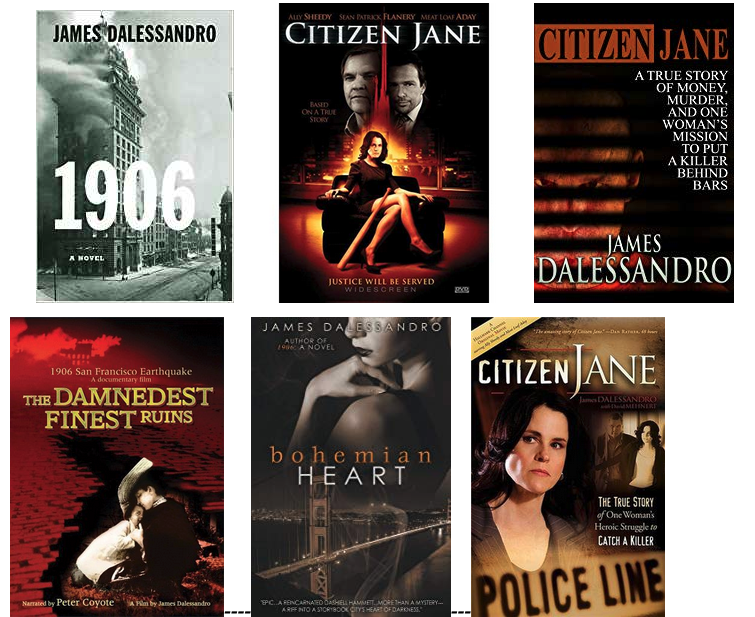
Dalessandro’s books: Canary In A Coal Mine (poetry), Bohemian Heart (detective fiction), Citizen Jane (true crime), and 1906 (historical fiction). Inspired by his 1906 research, he made the awarding-winning film, The Damnedest, Finest Ruins. The doc is a definitive look at the great quake and fire of San Francisco, and narrated by damnedest, finest narrator – Peter Coyote.
Citizen Jane, is a Hallmark TV movie Dalessandro wrote based on his true-crime suspense book about a local San Anselmo, CA woman who tracks down the killer responsible for her aunt’s grisly murder. The titular Jane Alexander’s murder-solving crusade and victim’s advocacy was precedent setting. The TV movie’s writing, cast, editing, and thriller elements are a standout. (Available free on Amazon Prime streaming.)
The Santa Cruz Poetry Festival, was called by co-founder Lawrence Ferlinghetti, as ushering in “A new era of American Poetry.” The Festival ran from 1973-1977.* Dalessandro taught “Screenwriting as a Pro” at Fort Mason Art Center and currently teaches screenwriting at Academy of Art University, both in San Francisco.
In 2016, Dalessandro wrote the pilot and bible for a series entitled Stan Lee’s—The Chosen and serves as Executive Producer. In the same year, he was hired by Los Angeles/Beijing Studios (LABS) as screenwriter and Executive Producer of a 6-hour mini-series on the life of martial arts icon Bruce Lee. He regularly commutes from Marin County, CA to L.A. to work on projects.
The Conversation:
Dalessandro invited me for lunch at longstanding Le Chalet Basque restaurant, near Frank Lloyd Wright designed Marin Civic Center. We had met a few years back when he spoke at a “Hollywood by the Bay” screenwriter’s workshop. Dalessandro is a tall affable man and looked sharp, sporting a white Stetson.
After lunch, he graciously invited me to his and his beautiful wife, Katie’s, nearby comfortable home. Settled into Dalessandro’s perfect writer’s den of broad desk, leather furniture, countless books and memorabilia, we continued our conversation.
MillValleyLit: Tell us about The Santa Cruz Poetry Festival event, which you co-founded with literary talent magnet, Lawrence Ferlinghetti, and directed for several years.
James Dalessandro: In grad school at Ohio University, I saw a documentary on the Beat Poets– Lawrence Ferlinghetti, Allen Ginsberg, and Gary Snyder. I had wanted to be a writer since I was a child and had been writing all the way through high school and college. That made up my mind about traveling to San Francisco. So I hitchhiked out here with a friend and when I got to City Lights books they told me I was ten years too late – the heyday of the Beats and the poetry readings had already passed.
The Santa Cruz Poetry Festivals
James Dalessandro: A friend took me to Ken Kesey’s farm in Oregon where I met Timothy Leary’s wife who was staying with Ken. Leary was doing six years in Folsom prison for getting busted with two joints. I said, “Let’s do a poetry festival” to raise some money and gain attention for Leary’s appeal. Ken said, “Yes.” Then Lawrence Ferlinghetti signed on, and he sent me to Michael McClure, on and on.
First night in Santa Cruz, in a howling rainstorm, 1,800 people lined up around the Santa Cruz Civic Auditorium. It was magic. I got a rousing ovation for my work there and at the University of Oregon with Kesey two years later – Ken and I were lifelong pals – and it convinced me I might be able to do this work. The Festival became legendary – we had bomb scares, Charles Bukowski and William Burroughs, the return of Bob Kaufman, jazz musicians like Charles Lloyd – another lifelong pal – plus Anthony Braxton and Ali Akbar Khan.
I did four readings at the Troubadour in Los Angeles with Bukowski, which is where he met his future wife, Linda King. I think we still own the attendance record there – half of Hollywood showed up. Bukowski owns it – I was his warm up.

MillValleyLit: Like you, I hitchhiked out from the Midwest, only to Hollywood first at age 19, and read Bukowski’s pieces in the L.A Free Press. I’d never seen anything that raw, that real. He totally blew my mind. I met Bukowski after he had drunk an entire iced-tub of bottled beer during what seemed like a reluctant reading in San Francisco. You were friends with Bukowski?
James Dalessandro: When we performed at the Troubadour, Bukowski drank a tub full of Heineken at each of the four readings. Bukowski was not the easiest to get close to, but we got along well. He taught me a lot, especially about historical fiction with a short story he wrote on the murder of the silent movie star Ramon Novarro. He told me to tell the truth about what happened, then use my imagination to fill in the blanks so that the small details, the emotion, the little guy who is left out of the big stories are woven into the fabric. I used that on both of my novels, Bohemian Heart and 1906.
MillValleyLit: You also worked with William S. Burroughs, Allen Ginsberg, Michael McClure, Gary Snyder. How crazy was it to be side by side with some of the best-known, and most challenging, poets of that generation?
Poetry Bomb Threat?!
James Dalessandro: It was heaven. I was the youngest of the group at 23. Ginsberg is a great poet, a towering figure, but a bit of an old grandmother in person. At the Second Annual Poetry Festival, he made me go over every reader on the poster, and explain who they were and why I invited them.
As Ginsberg was reading in front of 2,000 people – I was the only one willing to follow him – some locals in Santa Cruz called in a bomb threat because they couldn’t get in for free. After the police made me clear the auditorium, 2,200 people rushed back in. People aren’t known to break into poetry festivals – we considered that a pretty good sign.
MillValleyLit: Oh, wow.
James Dalessandro: At the party afterward, Bukowski got naked and put his arm around Ginsberg – there’s probably 200 people there – and said, “Go ahead, Allen, tell ‘em you haven’t written a good poem since “Howl.” Ginsberg loved the attention. Afterward, Kesey and Ferlinghetti both credited me with giving a new birth to American poetry – not a bad thing for a guy in his mid-20s.
William Burroughs was a remarkable guy, with that slow Midwestern drawl. I spent hours talking to him: he loved guns, especially old Colt revolvers. I spent time in his hotel room looking at his stash, including an old single-action Army Colt – my uncles were cops, so I knew a bit about firearms.
The Electric Ken Kesey Test—One Not Involving Acid
MillValleyLit: Burroughs perhaps didn’t know as much as he should have, considering he accidentally shot and killed his wife during one of his “William Tell” acts. You mentioned that meeting Prankster Ken Kesey was a memorable tale. Can we hear it?
James Dalessandro: I talked earlier about founding the Santa Cruz Poetry Festival at Kesey’s kitchen table on his Oregon farm. When Ken walked out to greet us in his bathrobe, the first thing you noticed is the amazing shoulders and neck on Kesey – he was a legendary college wrestling champion, strongest man I ever knew.
I was a carpenter then, 23, Ken was 35 and in amazing shape. He said, “You look like a wrestler.”
I told him I was, in high school and college. I think Ken wrestled my coach, who was an NCAA champion. He said, “Let’s go do some takedowns, I just cleaned the pig pen.”
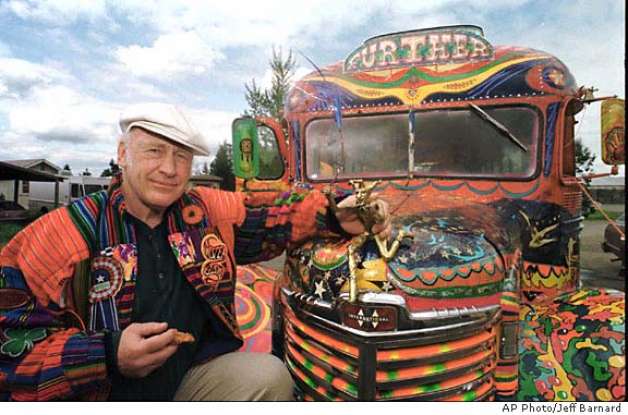
MillValleyLit: Come on. The pig pen?!
James Dalessandro: Yes. And so we did. In the pig pen. He killed me! I was 160 pounds, he was 220. Neither of us would quit. Every time I took a shower for two weeks, it burned like hell from the skin I lost. But he’s Ken Kesey! Loved him. He was going to write an intro to my novel 1906 but he… he died about a year before I finished it. We had also talked about editing a lot of film he had on Neal Cassidy and the Merry Pranksters into a documentary on his life.
Sometimes a Great Book, or Two
One of the saddest days of my life was the day he died – I heard it on NPR as I was driving home on the Pacific Coast Highway. I had to pull over and try to steady myself. His book Sometimes a Great Notion ranks up there with Steinbeck’s East of Eden in my opinion. We once spent four days together at a literary festival at Fresno State, he told me he could never write another book that good.
I told him, “Bullshit, you’re Ken Kesey. Find a subject worthy of your efforts.”
MillValleyLit: I’ve always thought that Notion was Kesey’s Pacific Northwest counterpoint to East of Eden. (Note: Some claim it is Faulknerian.) I was the only guy in an all women book club. On my turn to pick a book, I chose, yes, Sometimes a Great Notion. I had read it, maybe twice, but the women were resistant, probably due to its masculinity, and perhaps Kesey’s druggie rep. At our next meeting, they expressed surprise at much they enjoyed the book.
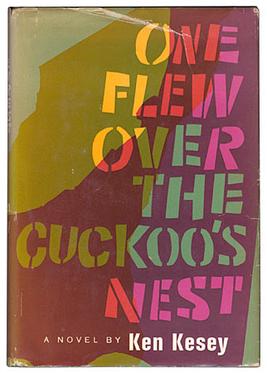 Kesey’s Cuckoo’s Nest —great, great film. Sometimes a Great Notion —some great scenes, like the trapped lumberjack, but not so good. (Note: despite its Oscar nominations). I’m glad Paul Newman made the effort, but… makes me wonder if it is like On the Road, despite the recent effort, still an un-filmable book. What do you know of Ken’s opinions?
Kesey’s Cuckoo’s Nest —great, great film. Sometimes a Great Notion —some great scenes, like the trapped lumberjack, but not so good. (Note: despite its Oscar nominations). I’m glad Paul Newman made the effort, but… makes me wonder if it is like On the Road, despite the recent effort, still an un-filmable book. What do you know of Ken’s opinions?
James Dalessandro: I never saw Cuckoo’s Nest until after Ken died – he never saw it and I promised him I wouldn’t either. The actual hero of the novel was “Chief,” not McMurphy – Ken hated what they did to his book. That probably dampened my enthusiasm for the film. His novel Sometimes a Great Notion rises on the strength of Kesey’s marvelous narrative prose – “…a vast smile of water with broken and rotting pilings jagged along both gums, foam clinging to the lips.” His ability to paint vivid, muscular images, full of thunder and emotion, has been a major influence on my fiction writing. Kesey and Steinbeck, the latter is my all time favorite.
MillValleyLit: I couldn’t agree more. However, they did turn his Cuckoo’s Nest into a “star” role for Jack Nicholson.
James Dalessandro: Nicholson was great as Randall McMurphy. I just had to respect the original writer, and if Ken Kesey was hurt by it, I had to share his pain. That’s how much I loved him. Kesey filed suit because Saul Zaentz owed him money. After Herb Caen wrote about it in his Chronicle column, Saul sent a check; I think it was for $750,000, within a few days. Ken was an artist; he needed the money, but he loved his baby more.
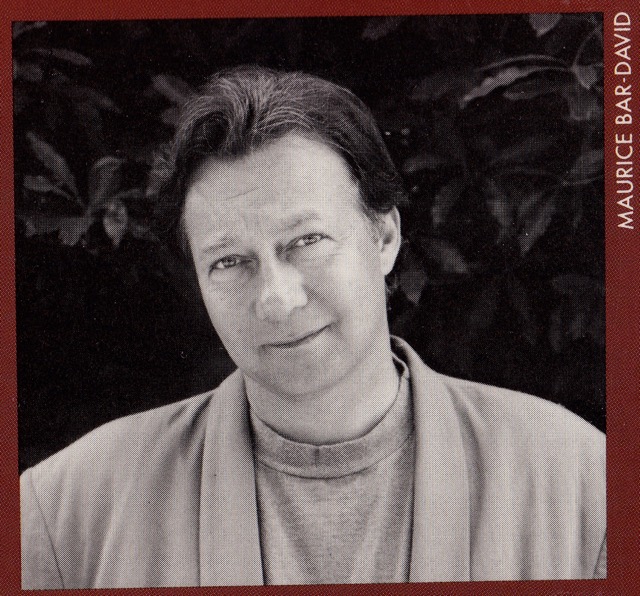
True Crimes and Meat Loaf
MillValleyLit: I can understand. I just watched Citizen Jane, the Hallmark TV movie you wrote based on your book, a true-crime thriller based on a vicious murderer who lived a few miles from here, in San Anselmo (CA). I was impressed with the writing, cast, editing, and thriller elements. With Ally Sheedy and…wow…Meat Loaf! What drew you to this subject?
James Dalessandro: I read a story in the Pacific Sun about Jane Alexander’s thirteen-year battle to track down the man who murdered her beloved aunt, and how she battled the criminal justice system the entire way. It was the only True Crime story in Hallmark’s long history – no one else was doing Movies of the Week when they hired me to write and produce it. That was a gamble for them.
It took me ten years to get it made – I had already sold it to CBS, Court TV – so I made more money on it NOT getting made than when it finally did. Ally Sheedy was a pain in the ass, never stopped complaining, didn’t want to talk to me because I was the writer.
Meatloaf stole the show as the weary, laconic cop – a real detective named John Kracht. Kracht was a real live Columbo who could stare down a rock. Meatloaf called me up two weeks before the shoot to go over the character. The Hallmark folks still talk about him – when he walked on the set, everyone stopped to look at him, including about twenty of my students who I used as interns on the film. It was a $2 million budget; we had eighteen days to make it. For what it was, it turned out well – it was very accurate to the real story.
MillValleyLit: On that budget and schedule—even more impressive. Your novel, Bohemian Heart, is an update of the classic Noir San Francisco Detective Thriller. It is a beautifully staged homage to the Maltese-Falcon City. There’s a Norton motorcycle-riding detective, cover-ups and betrayals, and a beautiful dame, of course. This novel paralleled the shocking Moscone-Milk murders. You drew a bead on the crazy circumstances that surrounded those… assassinations, really. After publication your interview remarks caused some concern in the inner circles. Here it is, forty years after those events, and the effects are still being felt. Comments?
James Dalessandro: I use real history in my novels – the injustice in the Moscone-Milk assassinations in Bohemian Heart and the lies and cover-ups in the 1906 earthquake. In Bohemian Heart, my private detective, Frankie Fagen, is the 4th generation descendant of honest cops who fought the City’s legendary corruption since the Gold Rush. He lost his job at the SFPD by claiming the trial for the murder of San Francisco’s gay mayor – a composite of Moscone and Harvey Milk – was a sham. In real life, the killer, Dan White, did 3 ½ years for killing two good men. This is justice?
I also called out Diane Feinstein for talking Moscone into giving Dan White his job back on the Board of Supervisors after White resigned. White was dangerous— unstable, an ex-cop and firefighter who had long been accused of gay bashing in high school. He was interrogated for twenty minutes about the murders, claimed it was all a blank. The infamous “Twinkies Defense” was only a small part of it.
Needless to say, the book got a lot of attention – the late, great Herb Caen wrote a big piece about it. I’ve sold it four times as a movie; it never got made. I love noir fiction. I tried to update the character, give him a history, a political attitude, a foundation in SF history. The book got amazing reviews. I am trying to turn it into a TV series today.
Hollywood Blues and Body Counts
MillValleyLit: I would certainly watch it, whatever format. Your love affair with San Francisco continued with your detailed historical novel 1906. Historical novels seem to be such a labor of love. How much of an effort was this one, and do you think you have another one in you?
James Dalessandro: I have officially identified the most difficult form of writing – historical fiction! It was indeed a seven-year labor of love. Every time you write a sentence, you have to check what they might have been wearing, were there gas lights or electrical, what was on the menu. It’s fun but exhausting.
Two years into the research and writing, the book outline sold in a bidding war to Warner Brothers and Barry Levinson. Now Brad Bird is allegedly going to direct the film, or a TV mini-series, after twenty years of development hell. I stopped writing the book to do three drafts of the screenplay. They spent twenty years throwing out my story and characters, then came up with a convoluted story about “pimp wars” between the notorious Chinatown madam Ah Toy and a Barbary Coast gambler and brothel owner named Jerome Bassity.
My story was about the honest cops who battled the corruption and Shanghaiing, about the fire Chief Dennis Sullivan who spent six years trying to get the city to build an auxiliary water supply system in case of another major earthquake. The city had burned down six times previously.
The day before the April 18, 1906 earthquake, indictments were handed down for the Mayor, political boss Abe Ruef, all eighteen members of the Board of Supervisors, the Chief of Police and a bunch of judges. The plot was hatched in Theodore Roosevelt’s Oval Office the previous October—his attempt to end Boss Rule in American cities. Some of the indicted officials struck back at their accusers, most likely burned down the house where the evidence was kept.
Then lied about the death count – claimed it was 478 – which City Historian Gladys Hansen and I got overturned in 2005. They claimed the Army rode to the rescue, maintaining order. What they really did was get drunk, start hundreds of fires with the mindless use of dynamite on wood frame buildings, and then shot a few hundred innocent people as suspected looters.
The real death count is now recognized as over 3,000** – it’s probably double that at least. Call me crazy, but that story trumps one about a faux pimp war. I believe in historical fiction, not historical fraud. A small measure of redemption came in 2016, when both Citizen Jane and 1906 became #1 nationwide in Kindle/Digital editions in True Crime and Historical Fiction, respectively.
We’ll Green-light this Serious Drama. Once We Rewrite to Appeal to ADHD Teenagers
I’ve been wanting to talk to Brad Bird as I’ve been trying for years to get Warner Brothers to go back to the original 1906 story – the fictional elements are minor, the big picture is impossible to beat. Unless, of course, you are expecting a prequel to the San Andreas movie where The Rock would, let’s say, go back in time to save his own grandmother from a tsunami. (Ed. updated note: The Rock=Dwayne Johnson)
MillValleyLit: (Laughs) Wait. I laugh, but Hollywood would actually do that. It’s like they hope doing something utterly ludicrous could luck out to make a blockbuster. “Yeah, let’s do a perverse-reverse psychology—The Producers strategy. (Both laugh.) What can you tell us about your current Stan Lee project?
James Dalessandro: Stan Lee had this great idea—I’m not a Superhero guy, far from it— but I thought this idea was great. A big city homicide detective, full blood American Indian, who suddenly inherits the spiritual powers of his ancestors. I flipped. Three other writers had failed to come up with a good “take” on the character and story.
I told Stan’s partner, on a street corner, what was wrong and what needed to be done. I agreed to do it on spec (speculation) if I owned the TV Pilot and the Bible. So I made a partnership with Stan Lee. Great guy, amazing guy, one of those full-of-life characters. At 95, he’s still a dynamo. TV is the salvation of American drama and the resurrection of the anti-hero—never thought I’d live to say that. But it’s true—the movie business sucks, the great stuff is on TV. (Ed. updated note: Stan Lee sadly passed soon after this interview on Nov. 12, 2018.)
MillValleyLit: You’re so right! TV rides again. I hadn’t really considered the anti-hero angle, but, let’s see— Marvel\Stan Lee’s Legion, there’s Ray Donovan, Peaky Blinders, Breaking Bad, GOT’s Tyrion and Jamie Lannister of course. James, you’ve mastered many, many forms of writing. What’s the best thing about being a writer?
James Dalessandro: Me? The writer’s life—hang out with crazy, creative people. You live on the fumes. Judith Crist said Hollywood is the place that kills you with hope.
I’m partners with the former head of programming at HBO on a series called PETROSINO, about a legendary New York detective who almost wiped out the New York Mafia before they became the world’s most powerful criminal empire. Theodore Roosevelt was Petrosino’s best friend—my favorite president, crazy as he was. Based on my big Playboy article.***
The Italian Girl, my film on America’s incarceration of thousands of Italians in internment camps during WW II for no other reason than they were Italian. They performed an opera to entertain their captors and townspeople in Montana and won the hearts of everyone. I’m an opera fanatic. I’m Italian, with dual U.S. and Italian citizenship, and it strikes to the very core of me.
MillValleyLit: Everyone’s heard about the Japanese interment, but really not the Italians… Sounds fascinating. Keep us posted. James, last question— what’s your best tip for writers?
James Dalessandro: Shit, all my answers are about the work. That’s my Rorschach test. Married to an amazing woman for thirty years on September 26, which we’ll spend in Matera, Italy. I love my adopted home of San Francisco (and Marin) but would live in Italy tomorrow. The food, the history, the cinema, the architecture—I’m an Italian boy through and through. Have a dog named Giacomo Poochini. Life is good.
I was on the morning news in San Francisco for my 1906 novel, and the host asked me my secret for a successful writing career. Assuming I had one. “A wife with a steady job” was my answer. They were howling when I left.
END
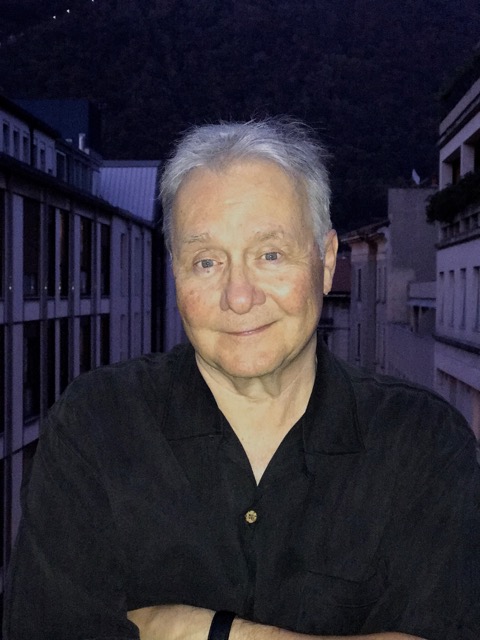
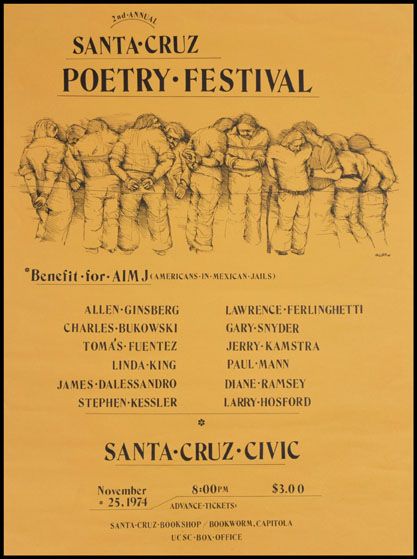
NOTES:
* Santa Cruz hosted five Poetry Festivals, beginning in 1972, and over the next decade featured the likes of Charles Bukowski, Lawrence Ferlinghetti, Allen Ginsberg, Amiri Baraka, F.A. Nettelbeck and Jerome Rothenberg. The last festival was held in 1981. A 2012 renaissance of the Festival was organized by Santa Cruz born poet, Daniel Yaryan. Yaryan is one of the West Coast’s most active promoters of poetry. His traveling poetry event “Sparring With Beatnik Ghosts” alternates between L.A. and San Francisco. Yaryan was a participant in the 2013 event “Beat at the Sweet” in Mill Valley, organized by poet/Beat expert Gerald Nicosia, which included a bounty of Beat and post-Beat readers, including Jerry Kamstra, Wavy Gravy, l Hinkle and other Kerouac associates, with MillValleyLit editors J. Macon King and Ari Maslow.
**1906 – The “official’ death toll from the quake was set at 478 people. But in the 1960s, when San Francisco librarian Gladys Hansen set about trying to match names to the number, she found that the death toll kept growing and growing. Over the next four decades, she would record more than 3,400 fatalities!
As the 100th anniversary of the natural disaster approached, Hansen and James Dalessandro wanted the current Board of Supervisors to set the record straight. “I believe they were trying to cover their behinds,” Dalessandro said. According to Dalessandro, whole communities were left uncounted. “Few, if any, deaths were recorded in the city’s densest area, Chinatown, which was destroyed.”
*** In 2010, “PLAYBOY” Magazine published his 7,000 word article, “PETROSINO vs. THE BLACK HAND,” the true story of a NY Shoeshine boy who was drafted into the NYPD, to fight crime in Italian run neighborhoods; beginning what would ultimately turn into an astonishing 26-year-career on the force. James sold a mini-series based on the “PETROSINO” article, to the FX Channel, where he was hired to develop the Pilot episode and Series Bible, with the help of his friend Bobby Moresco, Oscar-winning writer of “CRASH” and “MILLION DOLLAR BABY.”
5th Santa Cruz Poetry Festival poster (partials) 1977, below 4th Annual.
